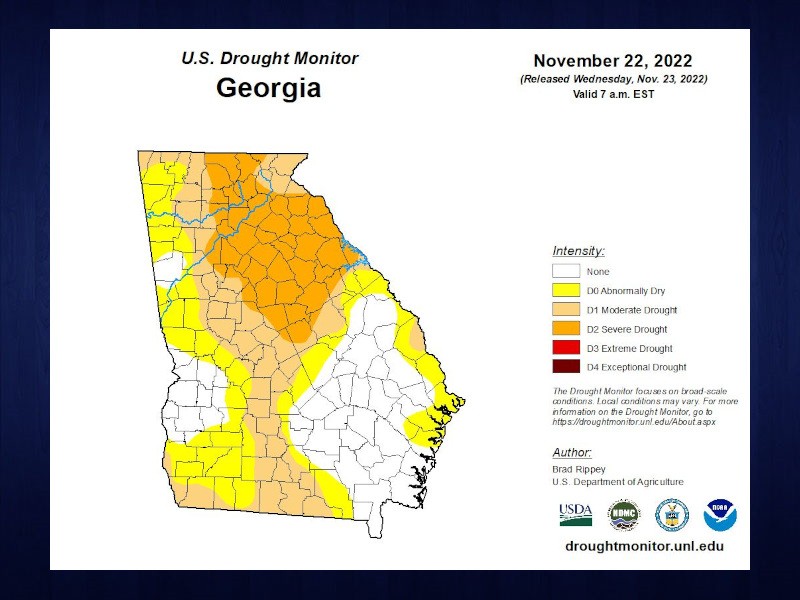Although it may not look like it, the northeast Georgia region is experiencing a severe agricultural drought. According to the U.S. National Weather Service report that was released on Nov. 22, about 20% of the state is in a severe, or D-2, drought.
This area includes Hall County, but Lincoln, Elbert and Wilkes counties have received the worst of the dry conditions.
State climatologist Bill Murphey said Georgia is currently experiencing the La Nino effect, which typically brings drier-than-usual, warm conditions and an active tropical storm season to southern parts of the state. Northeastern regions usually do not experience such dry conditions, but Murphey said Hurricane Ian is to blame.
“We did have some pretty good tropical activity if you remember Hurricane Ian back in late September, early October,” Murphey said. “But the problem was is when Ian came by us, it was to our east it. It was far enough offshore that put us on the real dry side of the system. And so it really dried us out [in] Georgia.”
Murphey said although South Carolina experienced beneficial rainfall from the hurricane, the precipitation stopped around the Georgia/South Carolina border. This dryness continued through October and in Hall County, rainfall was about 2.77 inches under-average for the month.
In the long term, Gainesville has been five inches of rainfall below normal for the past 90 days.
“Especially the month of October, it was cooler than normal but it was drier than normal,” Murphey said. “Normal is supposed to be 4.2 inches of rain – only got 1.43 inches of rain in October, for example. So that [was] in Gainesville, it was even worse over in Elberton and Lincoln County in that area, too. But the bottom line is those months you know, after Ian passed to our east really, we just never did pick up any rainfall during those months.”
This drought has mainly impacted farmers, which is why it is classified as an agricultural drought instead of a hydrological drought.
Cattle farmers, in particular, are struggling to cope with dry pastures and limited food supplies for their livestock.
“I've talked to the cattle farmers,” Murphey said. “Normally, they don't start feeding hay until like December, but they had to start feeding way, way early this year because of the drought conditions. A lot of them ran out of hay or are running out of hay, which is forcing some producers to even sell part of their livestock because they don't have the hay to feed them.”
Droughts also bring the increased possibility of wildfires. Murphey said these have not been extremely prevalent yet, but some of his constituents have noticed small burns that were brought under control.
“I can remember some folks on I-20, though, going up toward Augusta who were talking about seeing some quick little burns that were popping up along the side of the interstate that they were able to extinguish. But when we have these real dry funnel systems that come through, and the winds pick up, the fuels get really low and the moisture goes. Once you start a fire, it doesn’t take much to cause it to spread.”
Rain from Tuesday night’s storm system was an improvement in the short term, but according to the director of the University of Georgia Weather Network Director and agricultural climatologist Pam Knox, the state will need more rain in the long term to end the drought.
“On the longer term (3-9 months), that area is still in a rainfall deficit, so the deeper levels of the soil probably did not experience much relief,” Knox said. “So, the rain was very helpful, but we need more of it to eliminate all the drought conditions that have been occurring there.”
Knox said there may be a silver lining, as northeast Georgia is expected to receive more rain starting Saturday. Although it will take time for the rain to sink into the soil, Knox is hoping for eventual improved conditions.
However, increased rain during a drought can cause the potential for fast flooding from soil runoff. Since soils have been dried out, a sudden dump of rain can prevent the dirt from absorbing water.
“We're in the fall, where you got leaves clogging up sewers, drains, impervious surfaces, things like that,” Murphey said. “So it's easy for water to start accumulating pretty quick if it comes all at once – that's the main thing. And with the soil moisture, you know, a steady, slow rain would be nice, but that never happens these days.”
Residents from this area do not need to panic when it comes to water usage, but practicing effective water conservation is always highly encouraged. Murphey said people should consider watering plants later in the day when there is more sunlight and suggested putting mulch around plants, since plants will require less water. Some other lifestyle choices include installing low-flood toilets and limiting the amount of water used when brushing teeth or taking showers.
"There are a lot of different water conservation things that people can normally do that'll help," Murphey said. "But as far as the hydrological drought, we're not in that mode right now, which is good. I don't think we were heading that direction, but we are definitely in an agricultural drought situation."

















